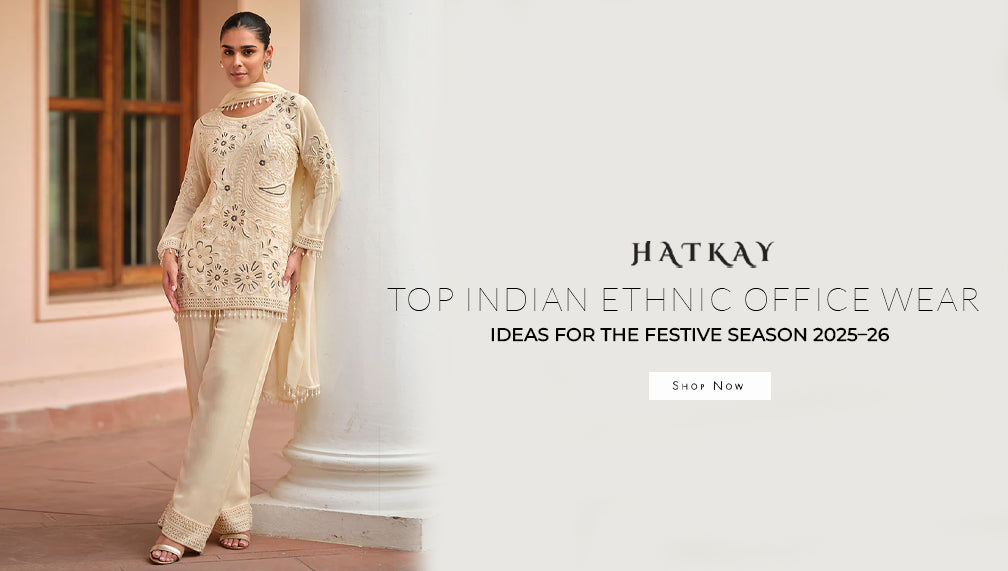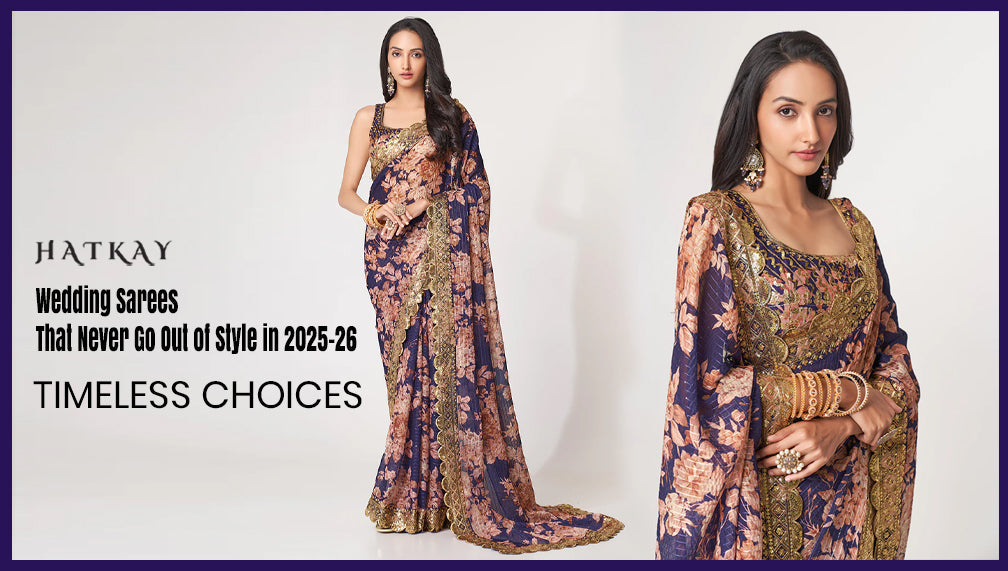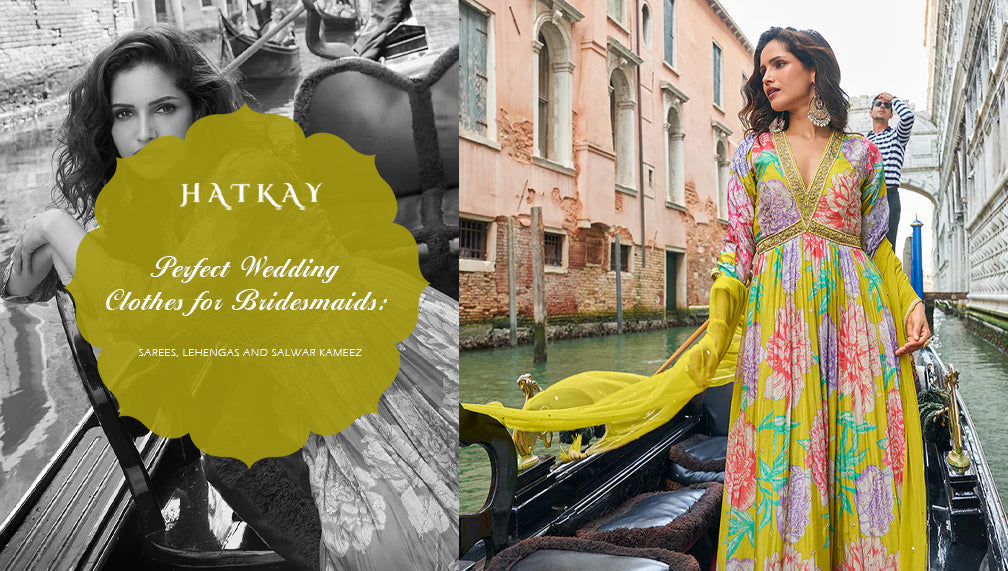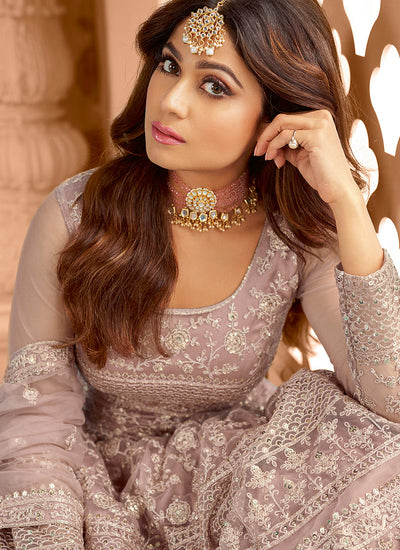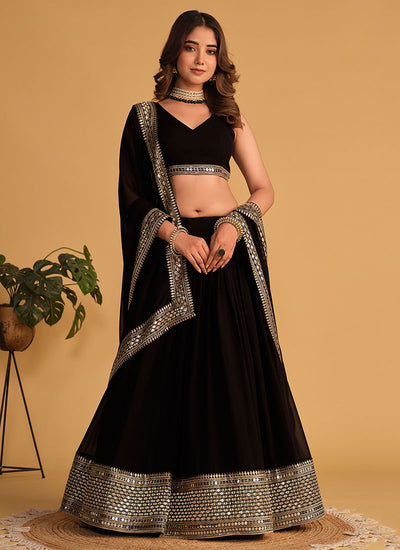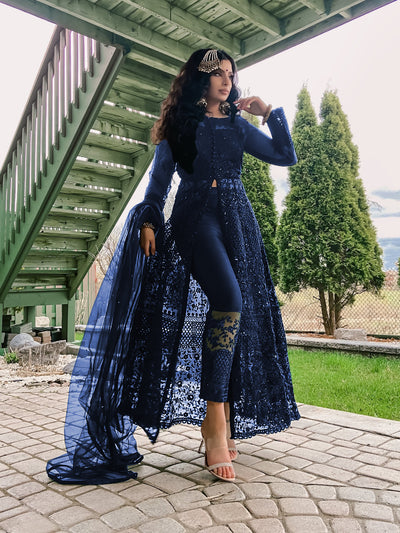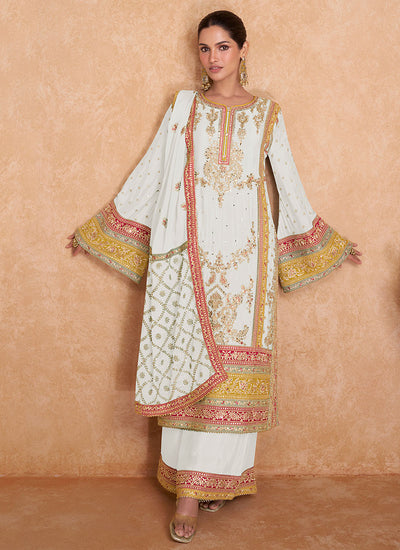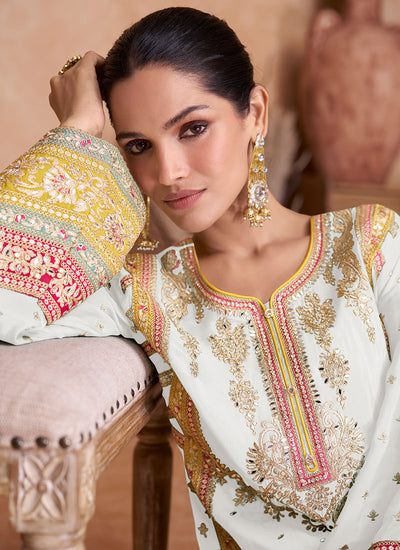
Sharara vs Gharara: How to Pick the Perfect One for Your Next Indian Wedding
Introduction
When it comes to Indian wedding outfit choices, one timeless debate continues: Sharara vs Gharara. Both are stunning, regal, and deeply rooted in traditional fashion, yet each carries its own charm. Whether you’re attending a grand wedding in Toronto, a festive event in London, or a Mehendi night in Sydney, choosing between a Sharara suit and a Gharara suit can define your entire look.
These two iconic silhouettes have returned to the fashion spotlight, adored by modern brides, bridesmaids, and wedding guests across the USA, UK, Canada, and Australia. But what exactly makes them different, and how do you pick the right one for your body type, event, or style?
What is the Difference Between Sharara and Gharara?
Let's clear this up first, as this is the most common question and the key to your decision. At first glance, they might look similar; both feature a short-to-medium length kameez (tunic), a dupatta, and wide-legged pants. But the magic, as always, is in the details.
The difference between Sharara and Gharara is all about the "where." Where does the flare start?
What Exactly is a Sharara Suit?
Think of a Sharara suit as the queen of dramatic flair.
A Sharara is a pair of wide-legged trousers that are completely loose and flowy, right from the waist to the hem. Imagine a pair of very, very wide palazzos or a divided skirt.
The Cut: The silhouette is an uninterrupted "A" shape. The fabric flows freely from the waist down, with no stitching or partition in between.
The Twirl Factor: This is where the Sharara wins, hands down. The sheer volume of fabric creates a magnificent, skirt-like effect when you walk, and especially when you twirl. This makes it a popular choice for Sangeet or Mehendi functions.
The Vibe: Playful, dramatic, and relatively more modern in its current iteration. It’s a favourite among Bollywood celebrities for a reason; it’s high-impact and incredibly photogenic.
You'll find types of Sharara suits ranging from simple printed cotton for a casual affair to heavily embroidered velvet or silk designer Indian clothes fit for a bride.
What is a Gharara Suit?
A Gharara suit is the Sharara's structured, aristocratic cousin. It’s all about regal elegance and a nod to royal heritage.
Here is the defining feature: A Gharara is fitted from the waist to the knees. At the knee (or just above), a dramatic, frilled, or gathered panel is attached, flaring out spectacularly to the hem.
The Cut: This two-part construction is the key. The top part hugs your thighs, creating a defined silhouette, while the bottom part provides the drama.
The "Gota": Traditionally, the joint where the gathered fabric is attached is adorned with an intricate band of lace or gota patti work. This isn't just decorative; it cleverly masks the seam and adds a touch of traditional luxury.
The Vibe: Nawabi, sophisticated, and deeply traditional. A Gharara suit carries an air of old-world charm and grandeur. It’s a silhouette that commands respect and feels incredibly special.
Sharara vs Gharara: The Ultimate Comparison
|
Feature |
Sharara Suit |
Gharara Suit |
|
Silhouette |
Wide and flowy from the waist down. |
Fitted from the waist to the knees. |
|
Flare Point |
Starts at the waist. |
Starts at the knees. |
|
Structure |
Uninterrupted flare (like a divided skirt). |
Two-part: Fitted thigh + flared bottom. |
|
Knee Joint |
None. A continuous panel of fabric. |
Has a distinct joint, often (but not always) decorated with gota or lace. |
|
Vibe |
Playful, twirly, dramatic, modern. |
Regal, structured, sophisticated, traditional. |
|
Best For... |
Sangeet, Mehendi, Cocktail parties. |
Nikkah, Reception, Eid, and formal dinners. |
A Royal Flashback: The History of Sharara and Gharara
To truly appreciate these outfits, we need to know where they came from. These aren't just clothes; they're pieces of history, carrying the legacy of empires.
The Nawabi Roots of the Gharara Suit
The Gharara suit is pure royalty. Its origins trace back to the Awadh region, specifically the courts of the Nawabs of Lucknow, during the 18th and 19th centuries. This was an era of immense cultural richness, poetry, and refined luxury.
The Gharara was the outfit of choice for the noblewomen of the Mughal and Awadhi courts. The intricate construction, the use of lavish fabrics like silk, brocade, and velvet, and the exquisite zardozi, kamdani, and chickankari embroidery were all symbols of status and refined taste.
Each Gharara suit was a masterpiece. The traditional Gharara, in fact, required up to 12 meters of fabric! The gota (the band at the knee) wasn't just a style choice; it was a feat of tailoring. This is one of the most iconic traditional Indian outfits (though its roots are deeply embedded in Mughal and Lakhnavi culture, which later became part of the broader South Asian heritage).
The Sharara's Bollywood-Fueled Revival
The Sharara suit also shares roots in the Mughal era but has had a more fluid evolution. While traditional Shararas existed, the version we love today, the dramatic, flowy pants, gained immense popularity in the 1960s and 70s, largely thanks to Bollywood.
Think of iconic actresses like Meena Kumari and Sadhana sashaying in wide-legged Shararas. These outfits became synonymous with glamour and cinematic drama. Then, like many fashion trends, it took a backseat for a few decades.
Fast forward to the 2000s and 2010s, and the Sharara made a massive comeback. Designers like Manish Malhotra and Sabyasachi reinvented the Sharara suit, making it the ultimate outfit for modern celebrations. Kareena Kapoor Khan's chartreuse Sharara in "Bole Chudiyan" (from Kabhi Khushi Kabhie Gham) arguably kicked off the modern craze, and it hasn't stopped since. Today, it’s a staple in NRI wedding fashion and a go-to for anyone wanting to make a statement.
Decoding the Styles: Types of Sharara Suits
Not all Shararas are created equal. The modern Sharara suit comes in various forms, each offering a different look. Understanding the types of Sharara suits will help you pick the one that flatters your body and matches your event.
1. The Classic A-Line Flared Sharara
This is the most common and universally flattering style. As the name suggests, it flares out gently in an "A" shape from the waist.
-
Best For: Almost all body types. For pear-shaped bodies, it gracefully skims over the hips. For apple-shaped bodies, it balances the silhouette.
-
Fabric: Works beautifully in flowy fabrics like georgette, chiffon, and crepe.
-
Style Tip: Pair it with a short, peplum-style kurti to accentuate your waist, or a classic straight-cut kurti for a sleek look.
2. The Tiered or Layered Sharara
This is for the fashion-forward guest who wants extra drama. This style features two or more layers or "tiers" of fabric, creating a voluminous, ruffled effect.
-
Best For: Sangeet or Mehendi functions where you want maximum twirl! It's fantastic for slender or athletic body types as it adds volume.
-
Fabric: Lightweight fabrics are a must; otherwise, it can look bulky. Think organza, net, and chiffon.
-
Style Tip: Keep the kurti and dupatta relatively simple. The pants are the star of the show here. A short, minimalist kameez lets the tiers do all the talking.
3. The Mermaid or Fish-Cut Sharara
This is a modern, fusion-style Sharara that's very close to a Gharara, but without the distinct seam. It's fitted through the thighs and flares out dramatically from the knees.
-
Best For: Hourglass figures, as it highlights your curves beautifully.
-
Fabric: Needs fabrics with some stretch and structure, such as stretch crepe, silk, or even velvet.
-
Style Tip: This style calls for a short, fitted kurti to showcase the silhouette. It's a bold look, perfect for a reception or cocktail party.
4. The Anarkali-Sharara Suit
This is a regal and very popular hybrid. It pairs a long, Anarkali-style kurti (often knee-length or longer) with Sharara pants.
-
Best For: All body types, especially if you want a more modest or traditional look without sacrificing the trend. It's also great for winter weddings.
-
Fabric: Silks, brocades, and velvets look stunning.
-
Style Tip: The key is balance. If the Anarkali is heavily embroidered, the Sharara can be simpler, or vice-versa. This is a favourite among wedding guest outfits.
Unveiling the Elegance: Types of Gharara Suits
The Gharara suit has fewer variations than the Sharara, as its defining feature (the knee joint) is what makes it unique. The types of Gharara suits are more about the tradition and the detailing.
1. The Traditional Lucknowi Gharara
This is the OG, the heirloom piece. Originating from Lucknow, this Gharara is all about authenticity.
-
The Gota: The joint at the knee is always adorned with a "gota," a traditional band of lace (often gold or silver) that is meticulously stitched on.
-
The Fabric: Often made from real kamkhwab (brocade), silk, or fine cotton, and embellished with intricate chickankari, zardozi, or mukaish work.
-
The Vibe: This is for the connoisseur. It's less about "fashion" and more about heritage. A Nikkah ceremony or a royal-themed reception is its perfect stage. Many Pakistani suits draw from this rich heritage, making the Gharara a beloved choice for Eid and weddings.
2. The Modern Flared Gharara
This is the contemporary take on the classic. Designers have played with the proportions to make it more wearable and, in some cases, more dramatic.
-
The Flare: The bottom flared panel is often much larger and more voluminous than the traditional version, using net, organza, or georgette to create a lighter, more ethereal effect.
-
The Joint: The "gota" might be replaced with a more subtle seam, a line of crystal embroidery, or a contrasting fabric piping.
-
The Kurti: Often paired with modern-cut kurtis, like cape-style tops, peplum kurtis, or even crop tops for a fusion look.
When you're browsing for a Gharara suit online, you'll likely find more of these modern interpretations, which are perfect for a fashion-forward guest at an Indian wedding.
The Main Event: Sharara vs Gharara for Every Wedding Function
Now for the practical part. You've got 3-4 events to attend. Which is better for an Indian wedding, Sharara or Gharara? Let's break it down by function.
1. Mehendi Madness
The Mehendi is all about comfort, bright colours, and sitting for long hours... but also about getting up to dance!
-
The Winner: Sharara Suit
-
Why: The uninterrupted flow of a Sharara suit is generally more comfortable for sitting cross-legged or lounging on gaddis (floor cushions). A lightweight, printed, or gota-patti work Sharara suit in georgette or cotton-silk is perfect. It's breezy, fun, and the twirl-factor is a bonus for those impromptu dance-offs. A Gharara's knee joint might feel a bit restrictive or bunch up when sitting for hours.
-
Colours: Think bright! Haldi-yellow, parrot-green, fuchsia, or vibrant teal.
2. Sangeet Sparkle
This is the night of dance, music, and high-energy performances. Your outfit needs to sparkle and move with you.
-
The Winner: It's a Tie (but Sharara has a slight edge)!
-
Why: A tiered or classic flared Sharara suit is made for dancing. The voluminous flare will create a stunning visual spectacle on the dance floor. However, a modern, lightweight Gharara suit can be just as dramatic, with the bottom flare kicking up as you dance.
-
The Deciding Factor: If you're in a group performance, a Sharara suit offers more freedom of movement. If you're making a grand entrance and want a more structured, high-fashion look, a Gharara is perfect.
-
Style: Go for bling! Mirror-work, sequins, and metallic embroidery are all welcome. This is where you bring out your inner designer in Indian clothes in UK.
3. The Wedding Ceremony (Pheras / Nikkah)
The main event is about tradition, respect, and elegance. The focus is more on grandeur and less on "party."
-
The Winner: Gharara Suit
-
Why: The Gharara suit wins for its sheer regal and traditional appeal. Its Nawabi heritage makes it especially perfect for a Nikkah ceremony. For a Hindu wedding, a heavily embroidered Gharara in silk or velvet, paired with a longer kameez, is a stunning and sophisticated alternative to a lehenga, especially for wedding guest outfits. It feels more "formal" and "ceremonial" than its playful cousin.
-
Style: Opt for rich, deep colours like maroon, emerald green, royal blue, or a classic red. Brocade, velvet, and zardozi work are perfect.
4. Reception Glam
This is the grand finale! The ultimate party. It's time to be a show-stopper.
-
The Winner: Both! (It depends on your vibe)
-
Sharara's Case: A modern, fashion-forward Sharara suit, perhaps a mermaid-cut or a heavily sequinned one with a stylish cape, is a statement-making choice. It’s chic, glamorous, and perfect for a night of cocktails and celebration.
-
Gharara's Case: A Gharara suit in a luxurious fabric like velvet or tissue-silk screams "red carpet." The structured silhouette feels incredibly formal and high-fashion. Paired with statement jewelry, it's a look of pure, unadulterated opulence.
-
The Verdict: How to choose the difference between Sharara and Gharara for the reception? Go Sharara for "Bollywood Glamour." Go Gharara for "Royal Elegance."
Style It Right: The Ultimate Accessory Guide
Choosing your outfit is only half the battle. Styling your Sharara suit or Gharara suit is what makes the look truly yours.
1. Jewelry Pairing: The Neckline Rule
-
For High Necks / Bandhgalas: Pull your hair back and focus on statement earrings (chandbaalis, jhumkas) and a maang tikka or passa (jhoomar). Skip the necklace.
-
For Deep V-Necks: This is your chance for a "wow" moment. A heavy kundan or polki choker, or a layered satlada (seven-strand necklace), looks magnificent.
-
For Sweetheart / Round Necks: A classic round necklace that follows the neckline is perfect.
-
Gharara Pro-Tip: Since a Gharara suit has a very Nawabi feel, a passa (worn on the side of the head) is an incredibly chic and authentic accessory to add.
2. Footwear Files: Heels vs. Juttis
-
The Problem: The hem of your Sharara/Gharara.
-
The Solution: You must get your pants hemmed to the exact height of the shoes you plan to wear.
-
Heels: Block heels or wedges are your best friends. They give you height without the risk of a stiletto heel piercing your delicate fabric or getting stuck in the grass at an outdoor Mehendi.
-
Juttis/Flats: An embroidered jutti is a comfortable and stylish choice, especially for Mehendi or Sangeet, where you'll be on your feet for hours. If you wear flats, ensure your pants are hemmed shorter so you're not sweeping the floor.
3. Dupatta Draping: The Make-or-Break
The dupatta can completely change your outfit's look.
-
The Classic Drape: Pleat it neatly and pin it to one shoulder. Timeless, elegant, and keeps your hands free.
-
The Royal Drape: For a Gharara suit, try the "Nawabi" style. Drape it over one shoulder, bring it around the front, and tuck the other end at your opposite waist. Or, drape it over your head and bring one end forward over your shoulder.
-
The Cape Style: Drape the dupatta around both shoulders like a cape. This is a modern, hands-free style, perfect for showing off a heavily embroidered kameez (and for hitting the buffet!).
-
The Wrist-Tuck: Pin it at the shoulder and loop the other end around your opposite wrist. This is very dramatic and great for Sangeet photos.
The Global Desi: NRI Wedding Fashion and Shopping
Finding the perfect Indian wedding outfit when you're not in India is a unique challenge. For the NRI bride, bridesmaid, or guest, the game is different. This is where NRI wedding fashion gets interesting.
The Rise of Sharara and Gharara in the West
Why are the Sharara suit and Gharara suit so popular among the diaspora in the USA, UK, Canada, and Australia?
They are a complete outfit: Unlike a saree, which requires skilled draping, a Sharara or Gharara is a "wear-and-go" three-piece set. This convenience is a huge plus.
They are fusion-friendly: The silhouette (top and pants) feels familiar to a Western wardrobe, making it an easy and comfortable transition.
They are unique: They stand out from the sea of lehengas and Anarkalis, offering something fresh and stylish.
The hunt for authentic Indian Clothes In the UK or a specific Sharara Suit In Canada used to mean waiting for a "trip to India" or relying on relatives. The options for high-quality Indian ethnic wear USA / UK / Canada were often limited, overpriced, or dated.
The Solution: Shopping for Indian Clothes Online
This is where the magic of online shopping comes in. Today, finding stunning Indian clothes online USA is easier than ever. You no longer have to compromise.
This is precisely the problem that Hatkay solves. Hatkay has become a go-to destination for NRIs because it bridges this gap, offering the latest designer Indian clothes and traditional Indian outfits with reliable international shipping.
When you're looking to buy Sharara suits online or buy Gharara suits online, you need a store that understands both quality and logistics. You need to see clear pictures, get sizing help, and trust that your outfit will arrive in time for the big day. Hatkay.com Indian outfits collection provides just that, shipping gorgeous, high-quality Indian ethnic wear directly to your doorstep, whether you're in New York, London, Toronto, or Sydney.
Your Perfect Pick: The Final Verdict
So, after this deep dive, we return to the big debate: Sharara vs Gharara.
Which is better for an Indian wedding, Sharara or Gharara?
The answer is... the one that makes your heart skip a beat.
Choose a Sharara Suit if: You are the life of the party. You value comfort and free movement. You want to twirl on the Sangeet floor and create dramatic, fun photos. Your style is more "Bollywood Glam."
Choose a Gharara Suit if: You are all about "less is more" (in terms of movement, not style!). You appreciate structure, heritage, and regal elegance. You want to make a sophisticated, queen-like entrance. Your style is more "Royal Heritage."
At the end of the day, both the Sharara suit and the Gharara suit are spectacular choices for any Indian wedding outfit. Both are beloved types of Shalwar kameez that have evolved into high-fashion statements.
Your final decision will come down to the specific event, the fabric, the embroidery, and, most importantly, how you feel when you put it on.
Why Sharara and Gharara Suits Are Trending Globally
A. The Return of Mughal-Era Glamour
Modern brides and wedding guests across the USA, UK, and Canada are falling in love again with heritage silhouettes. From lavish sangeet nights to reception dinners, the Sharara and Gharara are redefining Indian ethnic wear worldwide.
B. Celebrity Influence
Bollywood icons like Alia Bhatt, Kiara Advani, and Hina Khan have brought the Sharara suit back to red carpets and festive events. Pakistani celebrities also popularize Gharara suits, adding cultural elegance to wedding wardrobes.
C. The NRI Fashion Factor
NRI fashionistas prefer these suits because they’re:
-
Easy to pack and wear
-
Perfect for multicultural weddings
-
Available in fusion styles via Hatkay.com’s designer Indian clothes
Types of Sharara Suits
Let’s explore some of the most-loved types of Sharara suits trending in Indian clothes in the UK and across the globe.
Anarkali Sharara Suit – A royal blend of Anarkali kurta and flared pants.
Peplum Sharara Suit – Modern twist with short, structured peplum tops.
Cape Style Sharara Suit – Glamorous, perfect for cocktail or sangeet nights.
Straight-Cut Kurta Sharara Suit – Classic and elegant, ideal for daytime weddings.
Embroidered Designer Sharara Suit – Heavy zardozi or mirror work for bridal looks.
Styling Tip: Pair your Sharara suit with statement jhumkas and sleek juttis for an elegant Indo-Western vibe.
Types of Gharara Suits
The Gharara suit is a piece of art, traditional yet versatile. Here are the most popular styles:
Classic Gharara Suit – Rich brocade fabric, detailed knee joint, and heavy embroidery.
Net Gharara Suit – Soft, modern, and dreamy, perfect for receptions.
Velvet Gharara Suit – A winter wedding favorite for royal vibes.
Pakistani Gharara Suit – Intricate lacework and long kameez silhouettes.
Bridal Gharara Suit – Statement-making, embellished with zari, gota, and mirror work.
Fashion Note: If your event is grand and traditional, Gharara suits will make you look effortlessly royal.
Designer Inspiration from Hatkay
At Hatkay, you’ll find exclusive Sharara suits and Gharara suits inspired by Indian and Pakistani couture trends.
Top Designer Picks:
-
Sequined Anarkali Sharara for receptions
-
Embroidered Gharara suit with gota work for traditional brides
-
Peplum Sharara in georgette for Mehendi nights
-
Velvet Gharara with zari embroidery for winter weddings
Each piece from Hatkay.com celebrates modern elegance with traditional roots, perfect for every NRI wedding fashion moment.
Where to Buy Sharara and Gharara Suits Online
If you’re wondering where to buy Sharara and Gharara suits online, your search ends at Hatkay.com, one of the best online Indian clothing stores for Indian clothes online USA, UK, and Canada.
Why Choose Hatkay.com:
-
Exclusive designer ethnic wear collection
-
Global shipping (USA, UK, Canada, Australia, and beyond)
-
Custom stitching available
-
Trend-led designs for all body types
Sharara vs Gharara: Which is Better for Indian Weddings?
When it comes to Indian wedding outfits, both have their strengths; it depends on your taste and the occasion.
Choose Sharara Suits If You Want:
Lightweight, flowing comfort
A modern Indo-Western vibe
Versatility across events
Choose Gharara Suits If You Prefer:
Traditional, heritage aesthetics
Rich fabrics and intricate designs
A classic royal appearance
FAQs:
1. What is the main difference between Sharara and Gharara?
The key difference is the silhouette. A Sharara is a pair of wide, flowy trousers that are loose from the waist down. A Gharara is fitted from the waist to the knees, where a distinct seam or band (called a gota) attaches a voluminous, flared panel.
2. How to choose between Sharara and Gharara for my body type?
Sharara: Generally very flattering for all body types. A-line Shararas are great for pear shapes, while tiered Shararas add volume for slender frames.
Gharara: The fitted-at-the-thigh design is fantastic for hourglass and pear-shaped bodies as it highlights curves. If you are conscious about your thighs, you might prefer a Sharara or pair your Gharara with a longer kameez.
3. Which is better for an Indian wedding, Sharara or Gharara?
It depends on the event!
Shararas are perfect for Sangeet and Mehendi, as they are comfortable and easy to dance in.
Ghararas are often preferred for more formal events like the Nikkah, the main ceremony, or the reception due to their regal and structured look.
4. Can a bridesmaid wear a Sharara or Gharara suit?
Absolutely! A Sharara suit or Gharara suit is an excellent choice for a bridesmaid. They are modern, comfortable, and look fantastic in group photos. This is one of the best Indian wedding suits for NRI bridesmaids because it's a complete, easy-to-manage outfit that still looks incredibly dressed up. Coordinating colours or embroidery patterns for the whole bridal party can create a stunning, cohesive look.
5. Where can I buy authentic Sharara and Gharara suits online?
When you're looking to buy Sharara suits online or buy Gharara suits online, especially from abroad, it's crucial to shop from a reputable retailer. You need a place that guarantees quality, offers a wide selection of Indian ethnic wear, and has reliable international shipping. Portals like Hatkay.com specialize in Indian clothes online USA, UK, Canada, and more, offering a vast collection of high-quality Hatkay.com Indian outfits, including both traditional and modern Sharara and Gharara suits.
Conclusion:
The Sharara vs Gharara debate isn't about one being "better" than the other; it's about finding the silhouette that tells your story. Whether you're drawn to the playful, flowing drama of a Sharara suit or the structured, regal elegance of a Gharara suit, you are choosing an Indian wedding outfit steeped in history and style.
From a breezy Mehendi Sharara suit to a royal velvet Gharara suit for a reception, the possibilities are endless. And the best part? You don't have to be in India to find the perfect one. For those searching for a Sharara Suit in Canada or the latest Indian Clothes in the UK, the search ends with a click.































